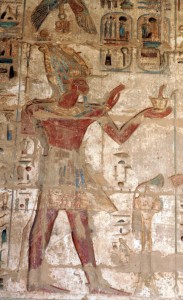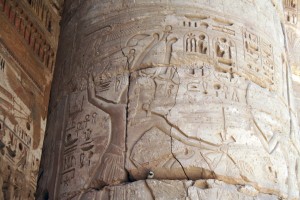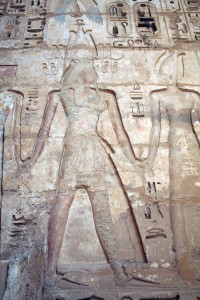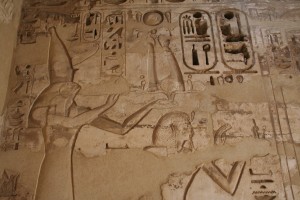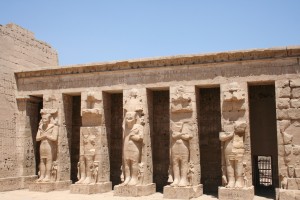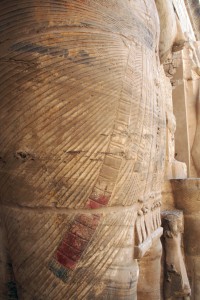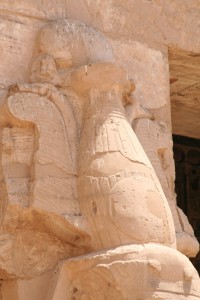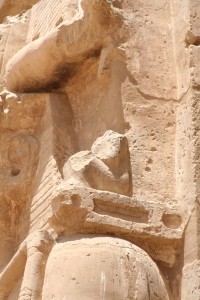One of the more elaborate crowns worn by the pharaoh is known as the atef. This crown appears first in the Fifth Dynasty and becomes more complex, with additional uraei (cobras) and other added elements during the early New Kingdom. When worn by the king, this crown signifies a connection of the pharaoh with Osiris, as divinized ruler of the Netherworld. It also has a connotation of renewal and is tied to the solar god, Re, who can embody cyclical time (neheh) in parallel with linear ‘Osirian’ time (djet). Unlike some of the other crowns, like the khepresh or nemes headdress, which appear often at Medinet Habu (197 times and 193 times, respectively), the atef is relatively rare. There are only 24 occurrences of this crown in the 765 scenes.
Fifteen of the appearances of the atef crown depict the king presenting an offering to the gods. Five of these show him presenting incense, three are food offerings, and one depicts pharaoh holding flowers. There is also single occurrence of the king presenting four cattle.
Offering incense:
The five remaining offering scenes show the king presenting spoil—four of these include foreign prisoners while one, found in the treasury, shows ingots of copper and piles of gold.
The crown appears in only one smiting scene, which is associated with the main portal of the Window of Appearance in the first courtyard.
The atef is also worn in one scene that shows the king processing among humans; an unusual depiction found in the northwest corner of the first courtyard. This is one of a set of scenes that frame the courtyard—they will be further explored in a future post.
The atef is worn by the king in another unusual scene found in the royal mortuary complex inside the temple proper. Here, the king is depicted seated within a shrine and is being worshipped as a divinity.
The remaining scenes where this type of crown is worn are all of the same ilk—they show the king being led into the presence of the gods to receive emblems of kingship and the right to rule or depict him actually receiving such items.

Several of these show the king holding hands with one or two deities, while one scene shows Ramses kneeling and offering Ma’at (symbolic of perfect cosmic balance and order) while a deity crowns him with the atef.
With one exception (which was clearly re-carved) the atef crown is always worn with the royal beard. When the king wears the atef, he almost always also wears a heavy shebyu collar (in 18 of the examples). A large looped sash is worn at the king’s waist in five of the instances—the corner scene, the smiting scene, the scene where the king offers flowers, and the two depictions found in the second courtyard where the king is led by two deities to be crowned.
This same looped sash is worn along with the beard and the atef crown by the anthropomorphic columns that stand on the north side of the first courtyard.
Although largely destroyed, a few of the seven engaged images are preserved enough to clearly identify the presence of these regalia elements in the king’s elaborate costume.
These colossal figures include a rebus image, worked into the crown and sitting on their shoulders, which spell out the name of the king—‘User-Ma’at-Re, Mry (‘beloved of’) Amun’.
As this brief discussion of the atef crown at Medinet Habu has shown, even using only frequency analysis can bring to light some very interesting and previously overlooked usage patterns. Since there are so few examples of this crown at Medinet Habu, it is possible to discern such patterns from this basic type of analysis—usage patterns for more common headgear, such as the khepresh, which appears in wide variety of contexts, are more efficiently examined using different types of complex forms of analyses. The scene types in which the atef crown appears are rather limited and specific. When chosen for offering scenes they tend to be those that show the king presenting spoil, an act that solidifies the king’s right to rule, or to items connected to revivification, like incense, flowers, and food. This pattern, especially when taken with its tendency to be worn when the king is being escorted by the gods or receiving emblems of kingship, ties in with the crown’s regenerative connotations and serves to embody the continuing, cyclical nature of kingship in ancient Egypt.

